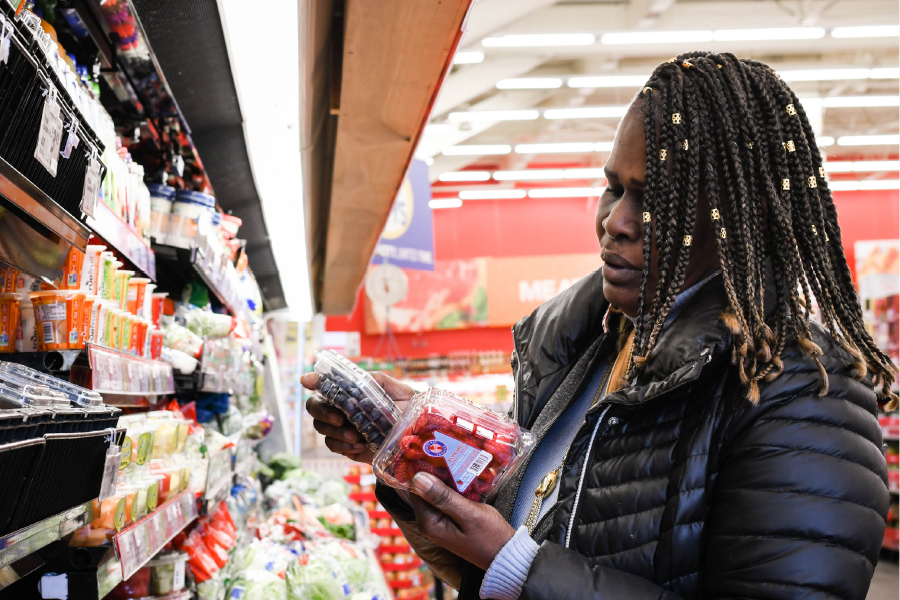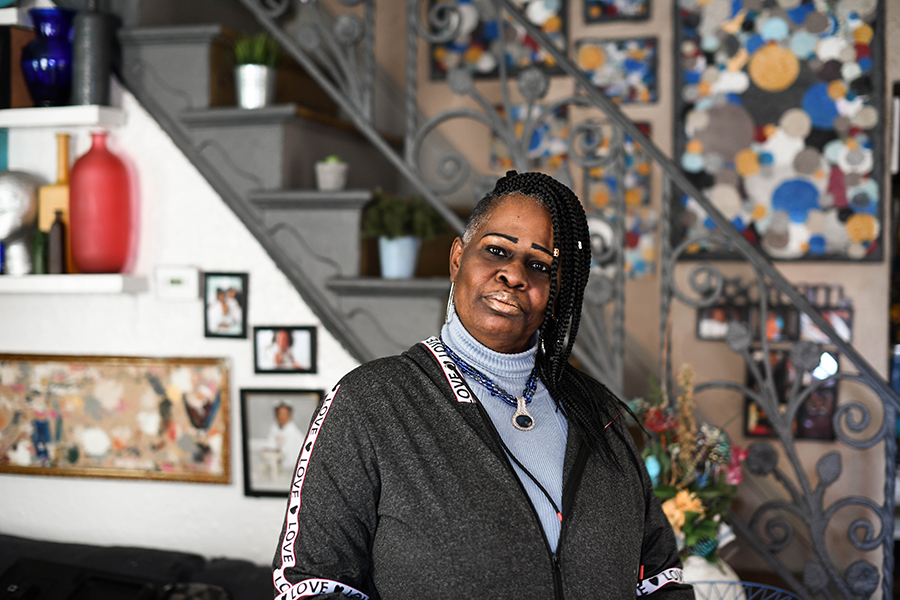In Philly, the Neighborhood You Live In Could Determine Your Lifespan. Activists Are Pointing to the Food We Eat.

Margaret Bowie had her first major heart attack five years ago. She had just walked upstairs to check the lottery number when she felt a pain in her chest.
“That’s when the first heart attack hit me so hard. Boom! Knocked me to my knees,” the 59-year-old says. Her first thought was not to seek help— she had gone grocery shopping that day, and she lives alone in her house in Germantown.
“I thought, who’s going to lock my house up?” she says. “I had just gone to the market, and I knew people would have cleaned me out.” Determined to lock her front door before she could be taken to the hospital, she worked her way to the bottom floor.
“I was like, ‘I got to make it, I got to make it.’ So I sat down one stair at a time,” she says. She made it outside, locked the door and collapsed into her neighbor, who contacted 911. At the hospital, her doctor revealed that before this incident, she already had three minor, undiagnosed heart attacks, and she would require triple bypass surgery. Two months later, before she could have the surgery, she survived another major heart attack.
“I tell everybody, God keeps sending me back. He says, ‘I’m not ready for you,’” Bowie says. “He keeps sending me back, and I’m here for a purpose.”
Bowie has struggled with a junk food habit since she was a child, and yet food is a precious resource—her grocery shopping consists of trips to the dollar store combined with purchases from the local bargain supermarket. This isn’t uncommon in her area. Residents of Germantown, like many other North and West Philadelphia neighborhoods that struggle with poverty, have on average lower lifespans and higher rates of high cholesterol, hypertension and heart disease than Philadelphia as a whole. According to a study by Philadelphia’s Department of Health, those who live in North Philly, as opposed to Center City, have a decreased life expectancy of nearly 20 years.

Retailers dealing in unhealthy food are clustered around low-income areas like North Philly.
Heart health issues point directly to food access.
Local and international organizations have observed that a lack of healthy food options in these areas—often termed food deserts or food swamps—may be the drivers of these diseases.
“A lot of the high-need areas we see, there is a relationship between lack of access to healthy food and rates of diet-related disease,” says Julia Koprak, senior associate at the Food Trust, a Philadelphia-based nonprofit that combats health disparities by increasing access to healthy options. “Philadelphia is a city where you see really high levels of health disparity, serious issues around poverty and hunger.”
In the case of East Germantown, close to where Bowie lives, residents went more than 40 years without a grocery store in their neighborhood. Rates of childhood obesity now equal about one out of every two children.
Bowie moved to Germantown when her two sons and her niece, whom she raised, were ages 6, 2 and 1. While they were growing up, Bowie would wake up early to cook them a healthy dinner they could reheat themselves while she worked at night. She had a car then, which allowed her to drive out to a grocery store in West Philly. Now that her children have moved away, Bowie looks after the kids in her community.
“At one point I had five brothers and sisters on the street, and I always hoped that somebody would look out for them, feed them,” Bowie says. She says she watches out for hundreds of kids in her neighborhood, some of whom are homeless, and many of whom are hungry.
“If you’re hungry I’ll feed you,” Bowie says. “If it’s really cold out, I’ll let you spend the night. My son tells me, ‘Mom, you can’t save the world.’ But I can at least try something.”
Even for the children who have food, she worries about their health.
“A lot of parents have to work more today, so they’re not home to feed their children,” she says. “You walk down the street, and we have Burger King, McDonald’s, Wendy’s, Popeye’s, pizza places everywhere. I tell them, I used to eat that junk food too. When you get older, it’s going to catch up with you.”
Since her heart attack, Bowie is trying to shop healthier, focusing on fresh fruits, vegetables and lean meats. But with limited funds—because of her heart issues, Bowie no longer works and depends on disability—buying healthy food in Germantown is not as simple as it may seem.
Grocery shopping in impoverished areas requires a complex negotiation between proximity, quality and affordability, as shoppers seek to navigate the convenience stores, dollar stores and low-end grocery stores that comprise the options in the area. This problem is severe in Philadelphia, in part due to the city’s rates of inequality and economic segregation, which are some of the highest in the nation. A Drexel study found that outside of Center City and University City, much of Philadelphia’s workforce is made up of service jobs with a median income of just $26,195, and unemployment reaches more than 25 percent in certain areas. Food deserts develop as grocery stores cluster around high-paying customers. Less than 1 percent of Center City residents are more than a half-mile away from a grocery store, according to city data, but in North Philly neighborhoods like Germantown and Belfield, that number can reach between 40 and 50 percent.

Shoppers make purchases at a farmer’s market set up by nonprofits.
“There is a lot of interest in eating healthy.”
Several public and nonprofit programs are working to bolster access to healthy food, largely led by the Food Trust, which is supported by the AHA. Founded in 1992, the Food Trust’s approach has served as an example for cities across the country. Their focus is twofold: affordability and accessibility.
“Accessibility (in terms of being able to shop) and being able to afford these items seem to be foundational in terms of dictating whether people eat these foods,” Koprak says. “There is a lot of interest in eating healthy.”
The Food Trust tackles affordability through its Philly Food Bucks program. About 26 percent of North Philadelphians rely on Supplemental Nutrition Assistance Program (SNAP) benefits, formerly known as food stamps. The Philly Food Bucks program provides SNAP users with $2 worth of fruits and vegetables each time they spend $5 in SNAP benefits at 26 farmer’s markets throughout the city.
The program can be critical for Philly’s poorest residents. SNAP benefits are issued at the beginning of each month, and users can struggle to make them last all month, either going hungry or relying on food banks toward the end of the month. By expanding SNAP’s value by 40 percent, Food Bucks support residents in need while encouraging healthy eating. There have been signs of success: from 2012 to 2015, SNAP usage at farmer’s markets rose by more than 300 percent, and by 2018, the Food Trust estimates more than 2,700 shoppers used Food Bucks at Philadelphia farmer’s markets, redeeming a total of $28,400.
The Food Trust has found support in this effort from partners like the AHA, who saw success in 2019 with monthly farmer’s markets in West Philly where shoppers could spend SNAP dollars and see cooking demonstrations using ingredients available at the market. The AHA plans to host additional markets this year.
Bowie occasionally takes the half-hour walk to Produce Junction, her closest farmer’s market, to use Food Bucks provided by her doctor. But the walk in the winter is cold, and the market only sells produce, which means grocery shopping requires an additional trip for meats and grains. That hits on a difficulty for farmer’s markets—when options are limited, people with finite time and resources may seek out other sources of food. A bigger hurdle may simply be the seasons—many markets close in winter. Ultimately, the impact of farmer’s markets is limited. Shoppers using Food Bucks at farmer’s markets represent less than 1 percent of the more than 450,000 Philadelphians who used SNAP in 2018.

Residents like Bowie depend on the Food Trust’s efforts for healthy food.
To find the solution, look to the problem: corner stores.
More permanent structures can help people develop good habits year-round. To that end, the Food Trust developed two trademark initiatives to fix places where people already shop, and create stores where there are none—in other words, clean up the bad and build up the good.
The Healthy Corner Store Initiative takes a problem and turns it into a positive. Small food retailers— which include corner stores, convenience stores, dollar stores and drug stores—have thrived in areas where supermarkets have failed, with lower overhead and more processed foods that maximize profit, to the point
of undercutting supermarkets and reinforcing food deserts. According to a study published in the journal Pediatrics, 42 percent of Philadelphia students shop at corner stores twice a day, five days a week. Corner stores are where Bowie developed her habit when she was a child, she says.
The Food Trust is introducing fruits and vegetables, and sometimes even nutritional advice and health screenings, into those same stores. “We need to think about portals of entry in which our patients in our community normally gather, and how can we be in that space to address some of their health needs,” says Chinwe Onyekere, system director of community health and equity at Lankenau Medical Institute, a partner of the Food Trust. “Corner stores are already set distribution portals within a community. They’re there, they’re being used—how do we re-frame them to make them access points for healthy food?”
More than 600 corner stores in Philly have enrolled in the program, which has now gone national—most major cities now have a similar initiative.
Even with healthy options, corner stores focus on snacks over staples, which means food deserts still need grocery stores. The Food Trust’s most ambitious program is the Pennsylvania Fresh Food Financing Initiative (PA FFFI), which offers grants, tax credits and loans for independent grocers to create new supermarkets in low- and moderate-income areas. With $30 million from the state, the initiative financed 88 new or existing supermarkets and other healthy food retailers in Pennsylvania, beginning in 2004. The program was used as a model by the Obama administration for a Federal Healthy Food Financing Initiative, which has provided more than $500 million in financing nationwide.
Once the PA FFFI-financed stores have been constructed, however, they have to survive on their own, and the grocery store business is a tough one. By 2016, at least 22 of the stores had closed across the state. But Koprak is optimistic. Failed stores can sell their building to more affordable grocery stores, and PA FFFI recently received renewed funding from the state for the first time since 2010, which will enable the Food Trust to add a whole new wave of stores.
The program did help Bowie’s neighborhood. A PA FFFI loan supported the opening of a Fresh Grocer just down the block from her. By 2011, it had shuttered, but the owners decided the neighborhood could support their more bargain-focused brand, Save-A-Lot, which opened a few blocks away.
“I like to go in the middle of the night, after 12, because that’s when they put out the fresh meat,” she says. To stretch her dollar, Bowie buys meat and produce at Save-A-Lot and packaged foods at a dollar store.
Food Bucks are leading the way to a healthier future.
Better options could be on the horizon. In 2015, the Food Trust began pilot programs to accept Food Bucks in several Philadelphia grocery stores and one corner store. Early results were promising. In 2018, the grocery stores and the corner store redeemed about $50,000 worth of Food Bucks—a little less than double the total redeemed across all 26 Philadelphia farmer’s markets.
Despite recent funding challenges, the Food Trust is about to expand the program for the first time since 2017. “It can be a challenge to continue to expand nonstop— absent additional funding,” Koprak says. “Having investment from state and city government, as well as additional philanthropic funding, would directly support the expansion of the Food Bucks program to more sites and with better technology solutions, and it’s something we are currently advocating for in Harrisburg.”
There is progress: The PA Farm Bill recently passed by the state includes expanded funding for Philly Food Bucks. But broader policy changes could help. A minimum wage increase, endorsed by the AHA for its potential to increase healthy food access may be the simplest way to provide the cash- flow necessary to attract and sustain supermarkets across Philadelphia. But Koprak cautions that maintaining the status quo takes work as well. The recently passed federal Farm Bill only made it through Congress after debate about limiting SNAP benefits. Reduced funding for SNAP would not just deprive people of food, but could create more food deserts, as many grocery stores depend on SNAP purchases.
As the policy debate shapes her neighborhood, Bowie does what she can for the kids around her.
“If you’re eating here, you’re coming to the market with me,” Bowie says. She taught her own children to eat healthy, and she wants to instill that in all the kids she looks out for.
“You want your children to be something better than you were,” she says. “Children learn what they live. One day, I want to be proud they became something in life.”
For more information on ways you can Go Red this year, visit phillymag.com/gored.
